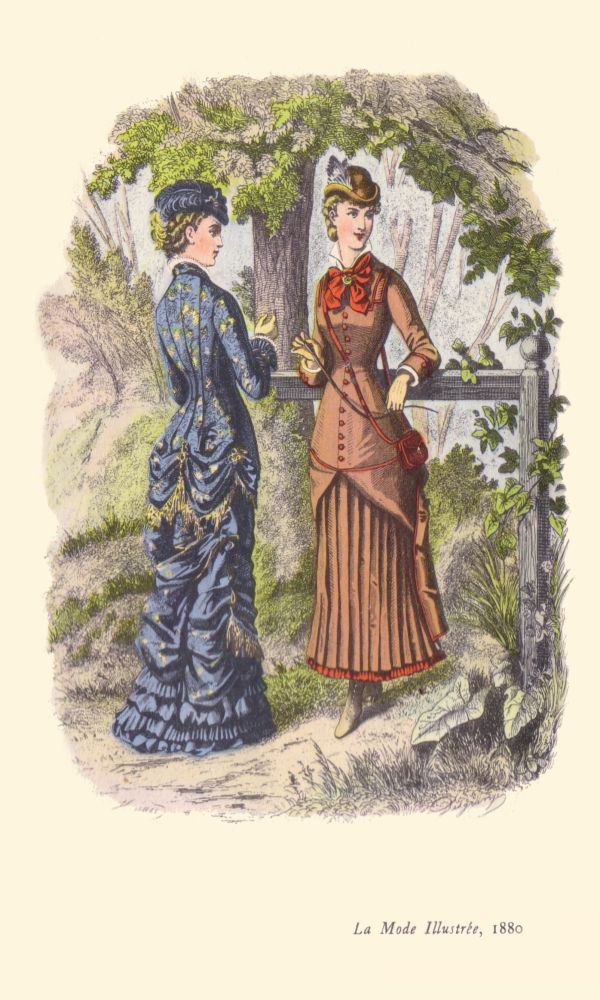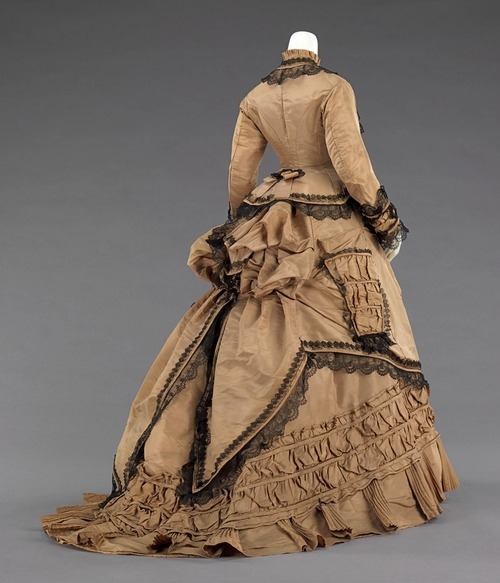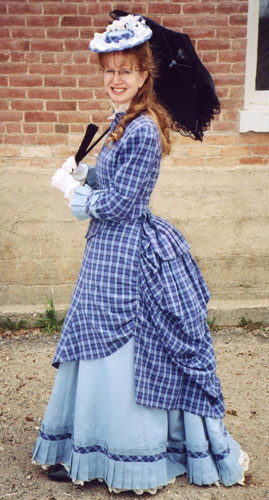Walking Dresses were worn to see and be seen. They are often referred to as Promenade Dresses, a very literal definition of their purpose....Walking Dresses differ for each location and season of the year. Because they were meant to be worn outdoors, the full costume of the Walking Dress always included a head covering of some kind, an outer garment or wrap, and gloves. Bonnets, caps, and veils were worn to cover the head, and were often the means of the most dashing or frivolous fashion statement.(From http://www.janeausten.co.uk/walking-dresses. The era might be a little early for my purposes, but the definition is about the same.)
 For my walking dress, I've chosen to go with a late Victorian, almost Edwardian silhouette, for a few reasons--First, conventions are crowded and the last thing I want is a six foot hoop skirt clogging up the hallways. Second, I likely won't get a chance to wear the dress before the convention, so a large bustle or anything that makes it difficult to wear is out of the question. Simplicity is the key here, since I've never really made a true historical garment before. Also, I know me and if I've got layers of big fluffy skirts, I'll probably tear them on something. And lastly, I simply prefer the look of that period to earlier Victorian garments.
For my walking dress, I've chosen to go with a late Victorian, almost Edwardian silhouette, for a few reasons--First, conventions are crowded and the last thing I want is a six foot hoop skirt clogging up the hallways. Second, I likely won't get a chance to wear the dress before the convention, so a large bustle or anything that makes it difficult to wear is out of the question. Simplicity is the key here, since I've never really made a true historical garment before. Also, I know me and if I've got layers of big fluffy skirts, I'll probably tear them on something. And lastly, I simply prefer the look of that period to earlier Victorian garments.
Here you can see the difference in the cuts. On the left is an image from 1880, and on the right two dresses from the 1870s.
Of course, that's not to say that I don't love 1870s fashion. I love how elaborate the skirts and bustles are, I'm just not feeling ambitious enough to attempt them.
Here are a couple of modern interpretations I'm using for inspiration:
(Yeah, I know, 1870s. But look at that skirt! And also, the jacket. I'm using a similar fabric and need a jacket, which is where I'm getting stuck.)
I adore the back of this dress. It might be a little more fanciful than what I'm after, but I definately want to use it as a jumping off point:
Speaking of jumping off points, I think is the direction I want to go in for the jacket:








Exquisite. I am sure you will be even more beautiful than the ladies in the photos.
ReplyDeleteHi Sheena are there big differences between British and American dresses in this period?
ReplyDeleteAlso in the 1870's when the big bustle and under hoop thing was going on, surely servants could not work in those clothes, so were their dresses always more naturalistic?
James In England
Hi James,
DeleteTo my knowledge there wasn't a huge difference between American and British fashion at this time. American fashions might have been a little behind the European (by anywhere from a month to a season, depending) but since American fashion at the time drew so much from it's European counterparts, they were extremely similar. Most of the delay was simply related to communication: time for plates (and later, photographs) of the latest fashions to make their way overseas and then spread through the US. Obviously, eastern cities like New York and Boston would be more fashionable than the larger cities emerging in the midwest and western United States.
Servants and other working class women did not usually wear bustles or hoops, except perhaps on special occasions (weddings, perhaps, or maybe to church on Sunday if they were slightly better off). By and large, however, their undergarments would have been much lest restrictive. Any fullness in their skirts would have been the result of 1-3 petticoats, depending on the season and if they could afford the material for them. In most cases, they wouldn't have worn bustles at all. This had as much to do with the practicality of wear as it did with the price of hoops and the wire frames that formed the bustles as it did with the difficulty of dressing onself. If you are watching a period film, take a look at the blouses of the higher class women compared to the lower class. Upper class blouses generally have many tiny buttons running down the back (which would require the aide of a servant) while lower class blouses would have fewer buttons, down the front, or be laced shut--easy for a woman on her own to put on.
Hope that answers your question. Thanks!
~Sheena